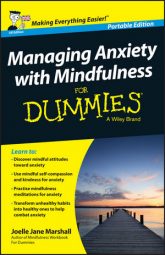This mindfulness exercise is called STOP, which stands for Stop, Take a breath, Observe and Proceed. You can use it when you feel your anxiety start to arise. As it’s only a short meditation, it can be used anywhere; you don’t need to set aside 30 minutes of your time to sit still or lie down.
Stop.
If you are in the middle of something take some time to stop if you can. If you’re feeling anxiety but think you are too busy to stop, that’s when you really do need to stop and take a break.
Take some mindful breaths next.
If it helps, place a hand on your stomach and feel how it goes up and down as you breathe in and out. What you are doing now is focusing your attention on the breath and away from any emotions, thoughts and bodily sensations.
Observe.
When you are ready and you have focused your attention on your breath, start to become aware of all your bodily sensations. Concentrate particularly on any physical discomfort that you are having as a result of your anxiety. Bring a sense of acceptance to these sensations and see if you can allow them to be just as they are.
Feel them the same time as your breath and try to bring kindness and warmth to them instead of judging them if you can. If you get lost, go back to the breath and use it as a support to help focus on these sensations. After you have observed your body for a while, move on to your emotions and your thoughts. Try to watch the thoughts as an observer and allow them to pass in their own time without forcing them.
Proceed.
Gently bring your attention back to whatever you were doing. As you bring your attention back into your physical world, try to focus on what you were doing with mindful attention if you can. For example, if you are sitting at a desk typing, engage with the sensations of feeling your fingers on the keyboard and the weight of your body on your chair.
Just bring as much of a sense of acceptance and acknowledgment towards your feelings as you can, knowing that your feelings are temporary and will eventually go.

